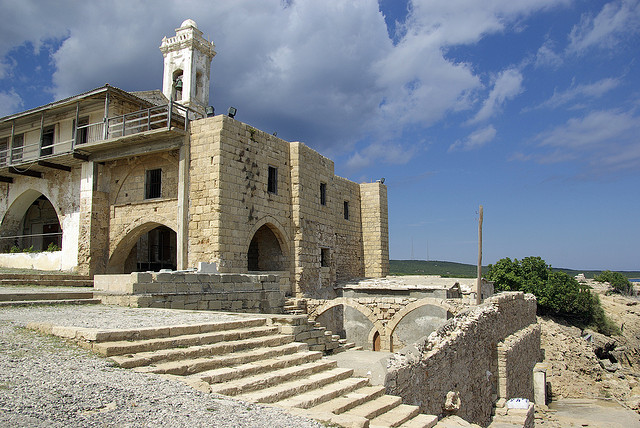 |
In the middle of the road, sheep from herds block your passage, making it impossible for a car to get by - images one rarely meets elsewhere. They graze in the nearby dry fields, on the left and on the right of the road. The rain has not come yet to quench the earth.
On the way, one has mixed feelings. This is your land, your place, and yet you see the red Turkish flags everywhere, piercing your soul.
Nearer the monastery, tame donkeys approach the cars on the road and stop them. They seem accustomed to taking food from the visitors.
The road leading to the monastery is dotted with potholes. Time has begun to take its toll on the whole area. The rooms that used to be so welcoming to the pilgrims are now deserted and derelict.
The donkeys seem to be the tourist attraction of the monastery, since many are roaming the front yard and enjoy the friendliness of the tourists that have come to see the Monastery.
The visitors stroke them, offer them food, are photographed with them...
A few paces away, the wild waves break on the rocks, where the holy water of the monastery can be found. The sea appears to be angry, wounded, and is spitting its temper on the rocks.
Thirty-eight years have passed and the waves still break on the rocks in a lament. The Turkish flags are flying in the yard, a rude contrast to the blue sea and the sanctity of the monastery. This monastery is a symbol of Orthodoxy, a sentinel of freedom.
Turks, who gather in the vicinity, try to sell their goods, including icons and crosses whose significance they ignore. Some try to sell empty plastic containers to visitors for the “holy water” they can get from a spring, on the wall of the monastery facing the sea, just round the corner.
The monastery is in a bad shape, no doubt about that: its wooden doors and windows are rotting away, its metal constructions are rusting and the plaster is falling off the walls, even the stone steps are in a dire state.
Time has also taken its toll on the arches of the building, dating to the Middle Ages. The steeple still standing there, the big church bell waiting to hear the good news of its liberation, to toll and break the news to the faithful.
Once inside the monastery, you stand in awe. A big icon depicting Saint Andreas, lit candles nearby and the somber figure of the elderly priest who conducts church services.
A warm welcome with a broad smile awaits visitors, obviously happy to see us.
Father Zaharias tells us of his concerns about the building, the corrosion of the walls facing the sea, the badly maintained ceiling.
He is hopeful that the church will, at the end of the day, be restored and is thankful to people who come to pay their respects and pray to the Saint, and contribute financially to the restoration effort.
Father Zaharias says that a lot of people, even Turkish Cypriots who are not Christian Orthodox, come here with respect.
Tourists flock to the place, to light a candle and admire the once majestic construction.
A UN patrol, belonging to the UN peace-keeping force in Cyprus, is also in the area.
As we leave the monastery behind, there is only one thought in our minds: how has this been allowed to happen, why is the monastery in such a dire condition.
The Head of the Greek-Cypriot Technical Committee on Cultural Heritage Takis Hadjidemetriou has told CNA that the decision of the Technical Committee, comprising Greek Cypriots and Turkish Cypriots, is to promote the restoration project on the basis of designs prepated by the University of Patras, in Greece.
He explained that "the necessary proposals concerning the restoration of the St. Andreas have been given to the United Nations Development Programme (UNDP) and now we are waiting for their response".
He said the cost is estimated at 1.100.000 euros and the first stage of the restoration project, to repair the actual church - will take two years.
The UNDP, he explained, is willing to take over other stages of the restoration project without waiting for first stage of the project to finish.
“The building is not in such a terrible state. It is not tragic. Nonetheless, we have to proceed as soon as possible with the restoration,” he points out, noting that the medieval part of the building needs to be restored urgently.
Concerning the other stages of the project, he said they involve other buildings of the Monastery which are adjacent.
Asked about funds for the project, he said the Monastery itself, meaning the Church of Cyprus, is set to pay for the cost.
Hadjidemetriou assured that funds will be made available, and if need be the entire project could be included in European programmes and finances can be secured through the UN as well, in addition to appeals to the people at large.
Neither the Church of Cyprus nor the UN wished to make any statements on the issue, when asked.
